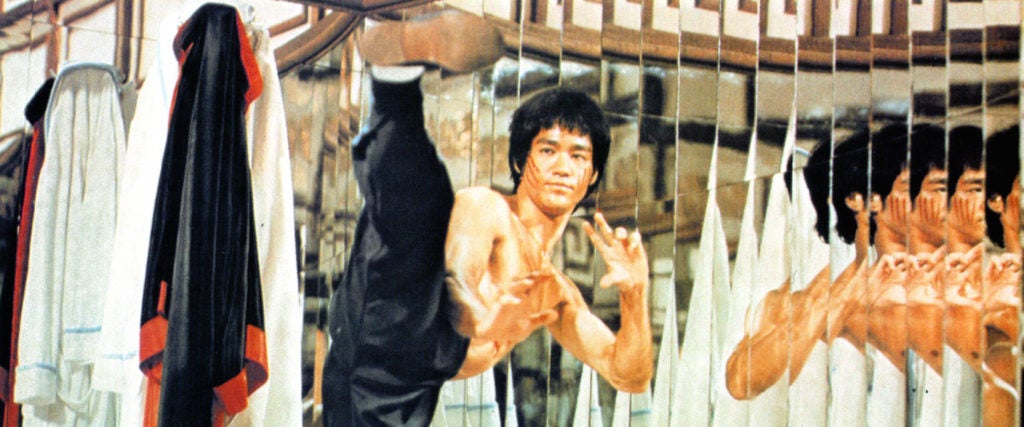On July 20, 1973, Bruce Lee died unexpectedly at the age of 32. A few months later, the release of Enter the Dragon brought him the global stardom that eluded him in his lifetime. An unexpected blockbuster, it would also create a demand for more Bruce Lee movies, even if Lee wasn’t around to make them anymore. The years that followed saw the re-release of Lee films that had been hits in Asia after he found stardom in Hong Kong, having left Hollywood frustrated by the limited options available to even the most charismatic Asian stars (even those with an astounding command of martial arts).
The flow of Lee and “Lee” movies didn’t stop there, however. A savvy Hong Kong producer repackaged scenes from Lee’s one-season series The Green Hornet as a feature film and dozens of shady “biopics” and deceptively packaged features starring Bruce Le, Bruce Li, Dragon Lee, Bruce Leung and so on rolled out in the years after his death, creating a sub-genre known as Bruceploitation. Lee’s influence stretched beyond his imitators, too: Theaters played host to martial arts movies starring others who emerged in his wake. Marvel Comics brought in its own Lee-inspired character, Shang-Chi: Master of Kung-Fu. Dojos filled with fresh enthusiasts and bedrooms filled with Bruce Lee posters. But none of it was enough to take Lee’s place. His story remained unfinished.
So did his dream project, a film called The Game of Death that Lee had begun shooting before pausing production to make Enter the Dragon. The Game of Death would have been Lee’s fifth feature since returning to Hong Kong, where he’d spent his youth and worked as a child actor. It would also have been his second film as a director and an extension of the explosion of creativity on evidence in Bruce Lee: His Greatest Hits, a new seven-disc set from the Criterion Collection that compiles those four features alongside a wealth of documentaries and other supplementary items. Among them: a disc dedicated to the 1978 film Game of Death, an attempt to salvage and rework the footage Lee completed before his death. The first such attempt, it wouldn’t be the last.
Released in 1978 and helmed by Enter the Dragon director Robert Clouse, Game of Death is by turns ghoulish, laughable and awe-inspiring. In this version, Lee and a handful of what can charitably be called lookalike actors — and in one especially awkward moment, a still photo of Lee’s face taped on a mirror — play Billy Lo, a martial arts movie star who’s run afoul of racketeers. To foil them, and protect his singer girlfriend Ann (Colleen Camp), Billy fakes his death, then infiltrates the forces of his enemy, leading to a string of battles on the upper floors of a suspiciously tall restaurant.
None of the plot of Lee’s original film remains in the finished movie, nor does all that much of the 100 minutes he’s said to have shot before pausing production. But what does remain is stunning. Lee — clad in a yellow tracksuit and matching Onitsuka Tiger sneakers, made iconic by the film and paid homage to by Uma Thurman in Kill Bill — takes on three foes: Dan Inosanto, Ji Han Jae and, most strikingly, basketball star Kareem Abdul-Jabbar, who’d trained with Lee in L.A. The sight of the 5-foot-8 Lee taking on the 7-foot-2 Abdul-Jabbar almost looks like an optical illusion. It’s also a showcase for both performers’ grace and skill that provides the otherwise iffy film with a suitably thrilling climax, helping make it a hit for Lee-starved fans years after his death.
Getting there, however, means first choking down a mix of the disappointing and the unpalatable. The plodding narrative falls into the former category, though a visit to a martial arts tournament featuring fight choreography by, and a brief appearance from, a young Sammo Hung has its moments. In the latter: Billy’s funeral, which tastelessly includes footage from Lee’s Hong Kong funeral, including a shot of the star’s corpse. It’s an appalling choice that doesn’t do much to fight the notion that the film itself is an act of grave robbery. (A 1981 sequel, which uses a few more moments of unused footage to kill off Billy Lo, doesn’t burnish the franchise’s reputation, either.)
That’s Game of Death, however, which significantly loses the “the” from Lee’s title, suggesting it’s just one possible Game of Death. The Game of Death itself remained unfinished, but what Lee did film offers a fascinating glimpse at what might have been, and one some have attempted to shape into something like the form Lee intended. Yet what might have been remains a bit nebulous, as Lee hadn’t quite worked out the plot when he began filming, not getting much beyond an outline that involved Lee’s protagonist Hai Tien and a group of allies attempting to ascend a five-level wooden pagoda in Korea, taking on a different sort of martial arts master at each level. Though his companions would fall, Hai Tien would have prevailed, in part because he learned ways to work against each discipline.
It would be a series of fights that doubled as a philosophical journey, an expression of Lee’s belief in Jeet Kune Do, the martial arts system he founded, one guided by the principles of adaptability and flexibility rather than an adherence to rules. Be Water, the insightful Bao Nguyen-directed Lee documentary that recently aired as an episode of ESPN’s 30 for 30, takes its name from the two-word phrase that doubled as a distillation of Lee’s philosophy, one that can be seen extending from his fighting style to his decision to seek his fortunes elsewhere when he kept hitting brick walls in Hollywood. Recently, as Danny Chau observes in a Atlantic piece, it’s found new life as a protest slogan in Hong Kong, another example of how Lee has come to mean much more than the films he left behind.
Lee intended The Game of Death to be the full expression of that belief, and the surviving footage suggests it could have been just that. But for a fuller sense, you’ll have to look elsewhere than the 1978 film. Both the 2000 documentary Bruce Lee: A Warrior’s Journey and Game of Death Redux, a new edit of the footage included on the Criterion set, offer a more complete — and much better — version of what remains of The Game of Death, one without the awkward edits of the Clouse-directed version, or any attempt to shoehorn the footage into a different narrative. It’s just Lee and his co-stars fighting in a series of scenes that capture both Lee’s talent as a martial artist and his emerging gifts behind the camera. (All that, plus weird shots of Abdul-Jabbar’s character wearing red contacts that reveal him as being super-sensitive to light, or maybe a vampire. It’s unclear.)
Of the two, Game of Death Redux has the slight edge, if only because it incorporates bits of John Barry’s Game of Death score, one of the film’s best elements. Neither truly closes the book on The Game of Death, however. Maybe nothing could, but that hasn’t stopped other filmmakers from using it as raw material and a way to comment on Lee’s legacy. Its incompleteness contributes to its allure. That helps explain the existence of Bruce Lee in G.O.D.: Shibôteki Yûgi, a 2000 Japanese film that also uses footage from The Game of Death, awkwardly incorporating it into a movie that’s part documentary — using interviews with Lee’s collaborators — and part stiffly acted biopic depicting Lee’s time working on the film.
It also explains Finishing the Game, a Justin Lin-directed mockumentary released in 2007 that fictionalizes the search for actors to replace Lee in Game of Death. Though wildly uneven, it scores some well-placed jabs, particularly in scenes featuring a would-be Lee who’s seen his years of acting preparation earn him a string of roles playing Chinese restaurant delivery men. Which speaks to another great what-if: What if Lee had lived to capitalize on the success of Enter the Dragon and his stardom changed the way Hollywood cast Asian actors?
It’s an unanswerable question tied to a film, and a life, defined by them. Including this one: What was Hai Tien looking for in that pagoda? According to Matthew Polly’s extensive 2018 Lee biography Bruce Lee: A Life, Lee hadn’t cracked it. “Bruce toyed with several ideas for the item — the Bible of Martial Arts, a mirror — but was unable to resolve what it should be,” Polly writes. “He planned to film the treasure reveal scene after he made the decision.” We see the stairs leading up to the final level. We even see Hai Tien descending the pagoda in exhaustion. But what he finds there remains unknowable. In Polly’s words, “Game of Death was an allegorical quest movie for an unknown item — a kung fu Pilgrim’s Progress.”
We’ll never see The Game of Death Lee wanted to make, and we’ll never know what Hai Tien was searching for. But like Lee, we know he was searching and we got to accompany him part of the way, and maybe that’s enough.

